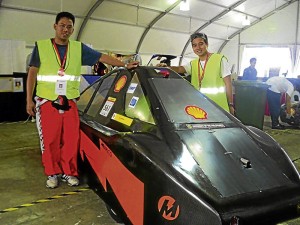
THUNDEROUS FEAT FOR UP’S KIDLAT This car—a diesel hybrid equipped with a GPS system—won the top spot in the Diesel Fuel-Urban Concept category. Photos by Emman Cena
SEPANG, MALAYSIA—For four days straight last week, the world famous F1 racetrack here was bedecked with small, oddly-looking cars in what was touted to be an out-of-the-box display of ingenuity by Asian students whose main purpose is to build the most energy-efficient vehicles. Some call it sacrilege—that instead of gas-guzzling Ferrari cars tackling the sprawling circuit what we saw were minute creations that could give the world’s automakers a run for their money.
Royal Dutch Shell was serious in this endeavor, bringing for the second time the Shell Eco-marathon to Asia and gathering about 94 student teams from 12 countries across the region. While at it, Filipino students made our country mighty proud. Of the seven entries from six local universities, two cars bagged coveted awards: University of the Philippines’ diesel hybrid Team Kidlat won the Diesel Fuel Award-Urban Concept Category while Team Cardinals Amihan of Mapua Institute of Technology was cited second rank for its safety features.
The Shell Eco-marathon is a competition that challenges students from all over the world to design, build and run a vehicle that can travel farthest with the least amount of fuel.
“This competition encourages our Filipino students to build more cars and technologies for greater energy efficiencies. We also hope to foster the same kind of enthusiasm, inspiration and awareness to our own students back in the country,” said Ed Chua, country chair for Shell companies in the Philippines, in a dinner with members of the press.
RAISE THE ROOF Pinoy student teams wave the Philippine flags in the opening of the 2011 Shell Eco-Marathon Asia.
Though held in Sepang, the cars in competition didn’t mean breaking speed records. Everyone was dead set on covering the farthest distance on the least amount of fuel while producing the least emissions.
Entries were divided into two main categories: “Prototype”—futuristic, streamlined vehicles focused on maximizing fuel efficiency through innovative design elements; and “Urban Concept”—more conventional four-wheel fuel-efficient vehicles. For both categories, teams entered their cars in two classes—electric mobility and internal combustion. Under the former vehicles can use any of the sources of energy such as hydrogen fuel cells, solar and plug-in battery. On the internal combustion class, student teams used fuels such as gasoline, diesel, gas to liquids (GTL) and FAME (fatty acid methyl ester).
Lightweight assembly
UP’s Kidlat is a car designed specifically to allow the engine to operate at its most efficient state. This is achieved through an efficient and lightweight assembly, as well as a diesel-electric hybrid system, said member Stanley Jordan Sahetiong. The UP team is composed of students from the mechanical engineering Department and the Power Electronics Laboratory (PEL) of the Electrical and Electronics Engineering Institute (EEEI).
For setting a new record of 2,213.4 kilometers on a liter of ethanol, a Thailand student team (under the prototype category) swept the field repeating their winning streak from last year. The distance covered is enough to drive from Kuala Lumpur to Chang Mai in northern Thailand. Last year’s record was 1,521.9 km/l—which could take them from Kuala Lumpur to Bangkok.
With the newly set Asian records, technical director Norman Koch had only good words for the teams: “What struck me different is that the design of the cars this year has remarkably improved. We are seeing a lot more reliability, teams being able to get more immediately on the track, not having to do quite so many reviews which comes through experience… but you can see the year on year improvement is dramatic, and you can only expect to improve that next year as well.”
SAVE A LITER FOR EVERY TANK The Filipino FuelSave team composed of Mel Anthony Endozo, Adrian Law, Patrick Villareal and Vanessa Santos emerged runner up in the 1-Liter FuelSave Challenge. With them are country ambassadors including our own Ryan Agoncillo.
Following its debut event last year, SEM Asia has attracted more participants, including new entrants Brunei Darussalam, Chinese Taipei and Vietnam. Off track awards for safety, Technical Innovation, and Communications and Design were also handed to several vehicles.
FuelSave challenge
At the sidelines of SEM was the Shell 1 Liter FuelSave Challenge, a contest in which everyday motorists were put to test to go the farthest distance on a liter of fuel in a typical car. Five teams from five countries battled it out on the Sepang race track.
A Filipino team of four composed of Mel Anthony Endozo, Adrian Law, Patrick Villareal and Vanessa Santos emerged runner up. They were selected via an online contest held early this year.
The Thai team repeated their feat last year with a combined average distance of 15.952 km/liter.
FuelSave ambassador to the Philippines Ryan Agoncillo also took part of the challenge.
Agoncillo took the wheel while media representatives Bum Tenorio, Angel Rivero and this writer stood as overly eager passengers as we negotiated the Sepang Circuit in an epic maneuvering, hair-pulling and fun experience thanks to Agoncillo’s drifting skills.
Each of the Shell FuelSave Teams will lead a campaign to inspire their own nation’s drivers to be more fuel efficient. They will also take part in a Guinness World Record attempt for the “Largest Fuel Efficiency Masterclass” to be held in some 10 countries simultaneously on Shell FuelSave Day on Oct. 15.